动词的非谓语形式有三种
三种非谓语动词的形式
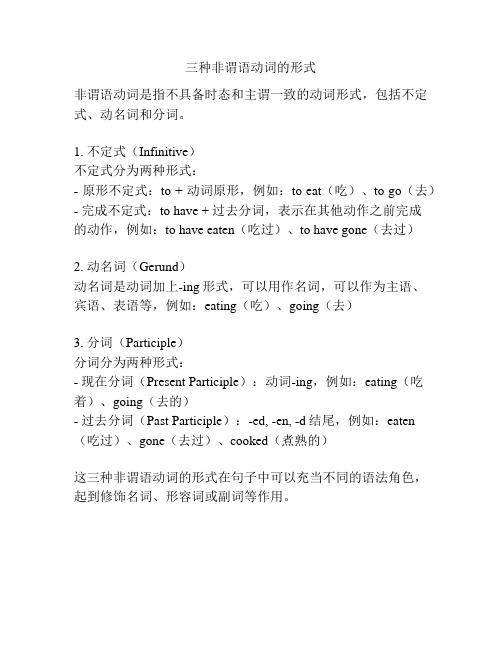
三种非谓语动词的形式
非谓语动词是指不具备时态和主谓一致的动词形式,包括不定式、动名词和分词。
1. 不定式(Infinitive)
不定式分为两种形式:
- 原形不定式:to + 动词原形,例如:to eat(吃)、to go(去)- 完成不定式:to have + 过去分词,表示在其他动作之前完成
的动作,例如:to have eaten(吃过)、to have gone(去过)
2. 动名词(Gerund)
动名词是动词加上-ing形式,可以用作名词,可以作为主语、
宾语、表语等,例如:eating(吃)、going(去)
3. 分词(Participle)
分词分为两种形式:
- 现在分词(Present Participle):动词-ing,例如:eating(吃着)、going(去的)
- 过去分词(Past Participle):-ed, -en, -d结尾,例如:eaten (吃过)、gone(去过)、cooked(煮熟的)
这三种非谓语动词的形式在句子中可以充当不同的语法角色,起到修饰名词、形容词或副词等作用。
非谓语动词的三种形式例句

非谓语动词的三种形式例句1. 引言嘿,大家好!今天我们来聊聊非谓语动词,别担心,不用像在课堂上那样紧张。
非谓语动词,听起来很复杂,但其实就是那些不和主语“打交道”的动词形式。
简单点说,就是它们不会像普通动词那样变来变去。
我们可以把它们分成三种:不定式、动名词和分词。
接下来,让我们用一些轻松幽默的例子来揭开它们的神秘面纱!2. 不定式(to do)2.1 说到不定式首先,不定式,就是那种带有“to”的动词,比如“to eat”(吃)、“to go”(去)。
咱们常常用不定式来表示目的或者想法。
想象一下,一个小朋友跑去妈妈面前说:“妈妈,我想吃冰淇淋!”这里的“to eat”就是不定式,表达了他的心愿。
2.2 例句分享再说个有趣的例子。
比如,有个朋友总是打算去健身房,但每次都是“计划去”(to plan to go)然后却又选择了沙发和零食。
我们可以说:“He wants to get fit, but he prefers to chill on the couch.”(他想要变得健康,但他更喜欢窝在沙发上。
)这个不定式真是形象地展现了他的挣扎啊!3. 动名词(doing)3.1 动名词的魅力接下来是动名词,这种形式听起来有点像个高冷的家伙,其实就是加上“ing”的动词,比如“eating”(吃)和“going”(去)。
动名词在句子里可以当名词用,简单说就是它能出现在主语或宾语的位置上。
想象一下,一个人正在享受美食,你可以说:“Eating ice cream makes me happy.”(吃冰淇淋让我快乐。
)。
3.2 有趣的场景再来个生活中的例子吧。
想象一下你和朋友在讨论周末的计划,你说:“I love hiking on we ekends!”(我喜欢周末去爬山!)这就是用动名词表达你对活动的喜爱。
可当你的朋友说:“I prefer bingewatching shows all day.”(我更喜欢一整天追剧。
高中英语语法非谓语动词
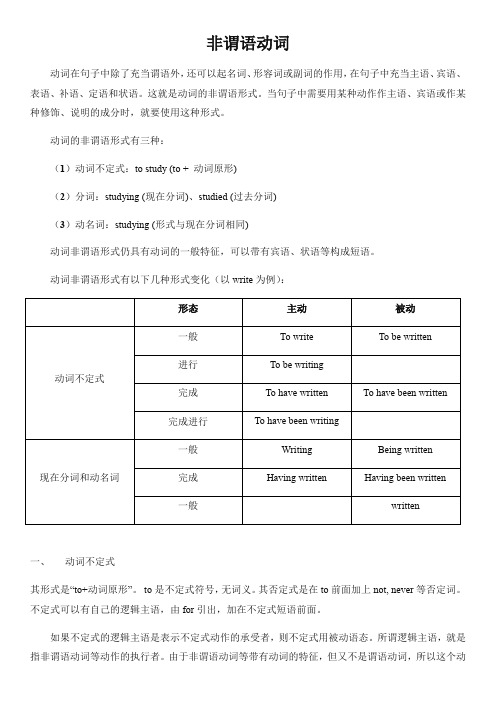
非谓语动词动词在句子中除了充当谓语外,还可以起名词、形容词或副词的作用,在句子中充当主语、宾语、表语、补语、定语和状语。
这就是动词的非谓语形式。
当句子中需要用某种动作作主语、宾语或作某种修饰、说明的成分时,就要使用这种形式。
动词的非谓语形式有三种:(1)动词不定式:to study (to + 动词原形)(2)分词:studying (现在分词)、studied (过去分词)(3)动名词:studying (形式与现在分词相同)动词非谓语形式仍具有动词的一般特征,可以带有宾语、状语等构成短语。
动词非谓语形式有以下几种形式变化(以write为例):一、动词不定式其形式是“to+动词原形”。
to是不定式符号,无词义。
其否定式是在to前面加上not, never等否定词。
不定式可以有自己的逻辑主语,由for引出,加在不定式短语前面。
如果不定式的逻辑主语是表示不定式动作的承受者,则不定式用被动语态。
所谓逻辑主语,就是指非谓语动词等动作的执行者。
由于非谓语动词等带有动词的特征,但又不是谓语动词,所以这个动作的执行者就不能称为主语,而在逻辑上又是这个动作的执行者,所以就称为逻辑主语。
如果不定式逻辑上的主语是这个不定式所表示的动作的承受者,这个不定式一般要用被动语态。
疑问词(who, whom, whose, what, which, when, where, why, how还包括whether)等后面加不定式构成不定式短语,可做主语,表语,宾语等。
(一)作主语。
在不定式短语作主语的句子中,往往用it 作形式主语,而不把不定式短语放在句子的后面。
如:To die like that is a terrible thing.=It is a terrible thing to die like that.象那样死去是一件可怕的事。
(it 作形式主语,把真正的主语to die like that放在后面)To know oneself is difficult.=It’s difficult to know oneself.有自知之明不容易。
动词的非谓语形式有三种

动词的非谓语形式有三种:不定式、动名词和分词。
一、不定式由“to+动词原形”构成,其否定形式是“not to do”。
不定式可以带宾语或状语构成不定式短语。
不定式没有人称和数的变化,有时态和语态的变化。
不定式可以作主语、宾语、状语、表语和定语。
不定式复合结构为“介词+sb.(sth.)+to do”,其中“介词+sb.(sth.)”表明不定式动作的发出者,为逻辑主语。
1. 不定式的用法:(1)作主语。
不定式短语作主语时,为了使句子结构平衡,常将不定式短语放在谓语之后,而用it作形式主语。
It is our duty to give as much help as possible. 提供尽可能多的帮助是我们的职责。
但不定式作表语时,前面有不定式作主语,不定式不可位于句末。
如:To see is to believe. 眼见为实。
(2)作宾语。
常见的只跟不定式作宾语的动词(组)有want, wish, hope, expect, would like (love),care, choose, learn, plan, prepare, mean, agree, promise, offer, refuse, ask, beg, decide, make up one’s mind, be determined, manage, try, can’t afford, fail, pretend等。
He promised to come today, but he hasn’t turned up yet .No one likes to be laughed at. 没人喜欢被嘲笑。
有形容词、分词、名词作宾补,不定式作宾语时要将不定式放于句末,用it 来作形式宾语。
如:You may find it necessary to finish the work ahead of time. 你会发现有必要提前完成工作。
非谓语动词的三种形式解析

非谓语动词的三种形式解析非谓语动词是指在句子中不担任谓语的动词形式,包括动词不定式、动名词和分词。
它们具有独立的语法作用,并能表达动作、状态或性质。
下面我们来详细解析非谓语动词的三种形式。
一、动词不定式动词不定式是动词的一种形式,通常由“to”加上动词原形构成。
动词不定式可以作为主语、宾语、表语、定语、状语等成分,具有时态和语态等变化。
1. 作主语:To learn a foreign language is beneficial for personal development.学习外语对个人发展有益。
2. 作宾语:The students want to visit the museum this weekend.这些学生想在这个周末参观博物馆。
3. 作表语:Her dream is to become a famous singer.她的梦想是成为一名著名歌手。
4. 作定语:I have a lot of books to read.我有很多书要读。
5. 作状语:He works hard to achieve his goals.他努力工作以实现他的目标。
二、动名词动名词是动词加上-ing构成的名词形式,具有名词的特点,可以担任主语、宾语、定语、表语等成分。
1. 作主语:Swimming is her favorite sport.游泳是她最喜欢的运动。
2. 作宾语:I enjoy playing the piano in my spare time.我喜欢在闲暇时间弹钢琴。
3. 作定语:The running water sounds very soothing.流水的声音听起来很舒缓。
4. 作表语:His hobby is collecting stamps.他的爱好是集邮。
三、分词分词是动词的一种形式,在句中可以作定语、状语等成分,常见的分词形式有现在分词(-ing形式)和过去分词(-ed、-en等形式)。
动词的非谓语形式有三种

动词的非谓语形式有三种动词的非谓语形式有三种:不定式、动名词和分词(一)不定式不定式由“ to十动词原形”构成,其否定形式是“ not to do”.不定式可以带宾语或状语构成不定式短语,没有人称和数的变化,但有时态和语态的变化.不定式可作主语、宾语、状语、表语和定语,但不能单独作谓语.不定式的逻辑主语有时用“ for十名词或代词宾格”构成.1.不定式的用法:l)作主语.不定式短语作主语时,往往放在谓语之后,用it作形式主语.例如:To see is to believe.It is right to give up smoking.2)作宾语.不定式短语作宾语时,如果还带有宾语补足语。
往往把不定式宾语放在宾语补足语之后,而用it作形式宾语.例如:He wanted to go.I find it interesting to study work with him.3)作宾语补足语.例如:He asked me to do the work with him.注意:在feel,hear,listen to,look at,notice, observe,see,watch,have, let,make等词后的补足语中,不定式不带to.但是这些句子如果变成被动结构时,就必须带to.例如I often hear him sing the song.He is often heard to sing the song.注意:不定式动词在介词but,except,besides后面时,如果这些介词之前有行为动词do的各种形式,那么,这些介词后的不定式不带to,否则要带to.如:She could do nothing but cry.What do you like to do besides swim?I have no choice but to go.4)作定语.例如:I have some books for you to read.注①作定语的不定式如果是不及物动词,或者不定式所修饰的名词或代词是不定式动作的地点、工具等,不定式后面须有相应的介词.例如:He is looking for a room to live in.There is nothing to worry about.Please give me a knife to cut with.但是,不定式所修饰的名词如果是time,place或way,不定式后面的介词习惯上要省去.例如:He had no money and no place to live.注②当作定语的不定式所修饰的名词或代词是不定式动作的承受者时,不定式既可以用主动语态,也可用被动语态,但其含义有所不同.试比较:A) Have you anything to send? 你有什么东西要寄吗?(不定式to send的动作执行者是you)B) Have you anything to be sent? 你有什么要(我或别人)寄的东西吗?(不定式to be sent的动作执行者是已被省略的me 或someone else)5)作状语,表示目的、原因、结果或条件.例如:I came here to see you.(目的)We were very excited to hear the news.(原因)He hurried to the school to find nobody there.(结果)To look at him, you would like him.(条件)目的状语还可以用in order to或so as to来表示.如:In order to pass the exam, he worked very hard.We ran all the way so as not to be late.不定式也可在作表语用的形容词后面作状语.例如:I am very glad to hear it.The question is difficult to answer.“ too十形容词或副词十不定式”作状语.例如:He is too old to do that.另外句子中有enough这个词时,常用不定式作状语.例如:The room is big enough to hold us.6)作表语.例如:My job is to help the patient.7)作独立成分.例如:To tell the truth,I don’t agree with you.8)不定式与疑问词who,which,when,where,how,what等连用,在句中起名词作用,可充当主语、表语、宾语等.例如:He didn’t know what to say.(宾语)How to solve the problem is very important.(主语)My question is when to start. (表语)注意:在与why连用时,只用于why或why not开头的简短疑问句中,后面紧跟的动词不定式不带to. 例如:Why not have a rest?9)不定式在句中用主动式还是被动式。
动词的非谓语形式

动词的非谓语形式:动词不做谓语时的固定形式。
(1) 动词的非谓语形式包括动词不定式、动名词和分词三种形式;其中分词又包含现在分词和过去分词两种形式。
它们在句子中不能单独作谓语。
(2) 动词不定式:①形式:动词不定式基本形式由“不定式记号to+动词原形”构成。
它的否认形式只要在“to” 前面加上“not”。
它的疑问形式是:“wh-疑问词+to+动词原形”。
*它的被动形式:“to be +过去分词”。
*它的完成形式:“to have +过去分词”。
②动词不定式具有名词、形容词和副词的特征,即可以在句子中作主语、宾语、定语、状语、表语和宾语补足语。
但不定式也保留动词的某些特征,即不定式后面可以跟宾语、表语和状语。
动词不定式加上相关成分就构成不定式短语。
③动词不定式可以放在谓语前句子作主语。
但是通常将作主语的动词不定式或不定式短语放在谓语后面,而在主语位置用“it”作形式主语(有时在不定式的前面还会用for sb.表示不定式的逻辑主语)。
如:To help animals is helping people.(帮助动物就是帮助人)/ It is very difficult (for us) to learn Chinese well.((对于我们而言)学好汉语是非常的困难)/ It took me half an hour to work out this problem.(解出这道题花了我一个小时的时间)④动词不定式可以作谓语动词(及物动词)的宾语。
[A] 及物动词+不定式一般形式:如:I would like to have a rest at the moment.(我现在想休息一下)/ They began to search the room for the thief.(他们开始在屋子里搜寻小偷)/ He liked to have aswim in the pool near his house.(他喜爱在靠家的水塘里面游泳)/ When did you learn to speak English?(你什么时候开始学英语的?)/ Don’t forget to close the door when you leave.(你离开时别忘了关门)[比较] He forgot to turn off the light.(他忘了关灯.) (没关)/ He forgot turning off the light.(他忘记关过灯.)(关了) / Please remember to ring me up.(记得给我打.)(还没打) / I remember calling you yesterday but you forgot.(我记得昨天给你打了,但是你忘记了.)(打过)[B] 及物动词+疑问词+不定式:如:He does not know which one to take.(他不知道该选哪个)/ Tell me how to get to the station.(告诉我怎么样去火车站)/ She asked me what to do for today’s homework.(她问我今天家庭作业做什么)/ Can you teach me how to search the internet?(你能教我怎样上网吗?)[C] 不定式作宾语而后面又有宾语补足语时,通常用it代替作形式宾语,而不定式则后置。
动词的非谓语形式有三种

动词的非谓语形式有三种————————————————————————————————作者:————————————————————————————————日期:ﻩ动词的非谓语形式有三种:不定式、动名词和分词(一)不定式不定式由“ to十动词原形”构成,其否定形式是“ nottodo”.不定式可以带宾语或状语构成不定式短语,没有人称和数的变化,但有时态和语态的变化.不定式可作主语、宾语、状语、表语和定语,但不能单独作谓语.不定式的逻辑主语有时用“for十名词或代词宾格”构成.1.不定式的用法:l)作主语.不定式短语作主语时,往往放在谓语之后,用it作形式主语.例如:To see is to believe.It is right togive up smoking.2)作宾语.不定式短语作宾语时,如果还带有宾语补足语。
往往把不定式宾语放在宾语补足语之后,而用it作形式宾语.例如:He wanted to go.Ifind it interestingto study work with him.3)作宾语补足语.例如:Heasked me to do the workwith him.注意:在feel,hear,listento,lookat,notice, observe,see,watch,have,let,make等词后的补足语中,不定式不带to.但是这些句子如果变成被动结构时,就必须带to.例如I oftenhear himsingthe song.He is often heard to singthesong.注意:不定式动词在介词but,except,besides后面时,如果这些介词之前有行为动词do的各种形式,那么,这些介词后的不定式不带to,否则要带to.如:She could do nothing but cry.What doyou liketodo besidesswim?I havenochoicebutto go.4)作定语.例如:Ihave some booksfor you to read.注①作定语的不定式如果是不及物动词,或者不定式所修饰的名词或代词是不定式动作的地点、工具等,不定式后面须有相应的介词.例如:He is looking for a room to livein.There is nothing toworry about.Please giveme aknifeto cutwith.但是,不定式所修饰的名词如果是time,place或way,不定式后面的介词习惯上要省去.例如:He hadno moneyandno placeto live.注②当作定语的不定式所修饰的名词或代词是不定式动作的承受者时,不定式既可以用主动语态,也可用被动语态,但其含义有所不同.试比较:A) Have you anything tosend? 你有什么东西要寄吗?(不定式tosend的动作执行者是you)B)Have you anything to be sent?你有什么要(我或别人)寄的东西吗?(不定式tobesent的动作执行者是已被省略的me或someoneelse)5)作状语,表示目的、原因、结果或条件.例如:I came here to see you.(目的)We were very excitedtohearthe news.(原因)He hurriedto the schooltofind nobody there.(结果)Tolook at him, you would like him.(条件)目的状语还可以用inorder to或so as to来表示.如:In order topass the exam, he worked very hard.We ranall theway so as not to be late.不定式也可在作表语用的形容词后面作状语.例如:Iamvery glad tohearit.The question is difficult toanswer.“too十形容词或副词十不定式”作状语.例如:He istoo old todo that.另外句子中有enough这个词时,常用不定式作状语.例如:The room is big enoughtohold us.6)作表语.例如:My job is to help the patient.7)作独立成分.例如:To tell thetruth,I don’t agree with you.8)不定式与疑问词who,which,when,where,how,what等连用,在句中起名词作用,可充当主语、表语、宾语等.例如:He didn’t know what tosay.(宾语)How to solve the problem is veryimportant.(主语)My question is when to start. (表语)注意:在与why连用时,只用于why或why not开头的简短疑问句中,后面紧跟的动词不定式不带to.例如:Why not have a rest?9)不定式在句中用主动式还是被动式。
非谓语形式
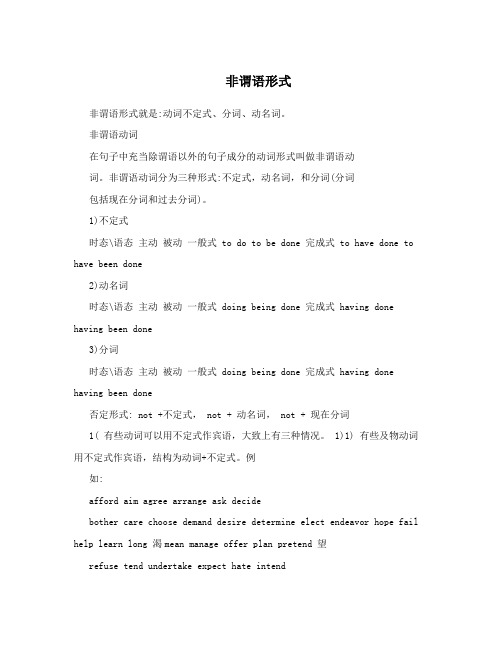
非谓语形式非谓语形式就是:动词不定式、分词、动名词。
非谓语动词在句子中充当除谓语以外的句子成分的动词形式叫做非谓语动词。
非谓语动词分为三种形式:不定式,动名词,和分词(分词包括现在分词和过去分词)。
1)不定式时态\语态主动被动一般式 to do to be done 完成式 to have done to have been done2)动名词时态\语态主动被动一般式 doing being done 完成式 having done having been done3)分词时态\语态主动被动一般式 doing being done 完成式 having done having been done否定形式: not +不定式, not + 动名词, not + 现在分词1( 有些动词可以用不定式作宾语,大致上有三种情况。
1)1) 有些及物动词用不定式作宾语,结构为动词+不定式。
例如:afford aim agree arrange ask decidebother care choose demand desire determine elect endeavor hope fail help learn long 渴mean manage offer plan pretend 望refuse tend undertake expect hate intend例如:The driver failed to see the other car in time. 司机没能及时看见另一辆车。
He offered to help me. 他表示愿意帮助我。
2)有些动词除了可以用不定式作宾语,还用不定式作补语,即有动词+宾语+不定式的结构。
例如:ask choose expect help beg intend like/love need prefer prepare want wish例如:I like to keep everything tidy. 我喜欢每件东西都保持整洁。
英语非谓语
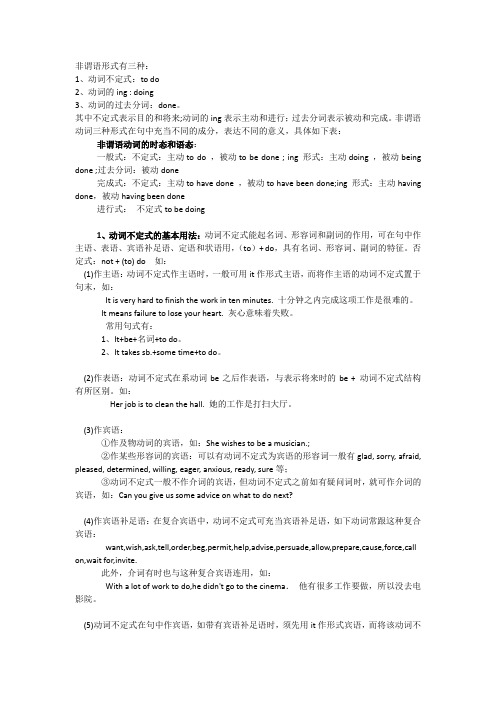
非谓语形式有三种:1、动词不定式:to do2、动词的ing : doing3、动词的过去分词:done。
其中不定式表示目的和将来;动词的ing表示主动和进行;过去分词表示被动和完成。
非谓语动词三种形式在句中充当不同的成分,表达不同的意义,具体如下表:非谓语动词的时态和语态:一般式:不定式:主动to do ,被动to be done ; ing 形式:主动doing ,被动being done ;过去分词:被动done完成式:不定式:主动to have done ,被动to have been done;ing 形式:主动having done,被动having been done进行式:不定式to be doing1、动词不定式的基本用法:动词不定式能起名词、形容词和副词的作用,可在句中作主语、表语、宾语补足语、定语和状语用,(to)+ do,具有名词、形容词、副词的特征。
否定式:not + (to) do 如:(1)作主语:动词不定式作主语时,一般可用it作形式主语,而将作主语的动词不定式置于句末,如:It is very hard to finish the work in ten minutes. 十分钟之内完成这项工作是很难的。
It means failure to lose your heart. 灰心意味着失败。
常用句式有:1、It+be+名词+to do。
2、It takes sb.+some time+to do。
(2)作表语:动词不定式在系动词be之后作表语,与表示将来时的be + 动词不定式结构有所区别。
如:Her job is to clean the hall. 她的工作是打扫大厅。
(3)作宾语:①作及物动词的宾语,如:She wishes to be a musician.;②作某些形容词的宾语:可以有动词不定式为宾语的形容词一般有glad, sorry, afraid, pleased, determined, willing, eager, anxious, ready, sure等;③动词不定式一般不作介词的宾语,但动词不定式之前如有疑问词时,就可作介词的宾语,如:Can you give us some advice on what to do next?(4)作宾语补足语:在复合宾语中,动词不定式可充当宾语补足语,如下动词常跟这种复合宾语:want,wish,ask,tell,order,beg,permit,help,advise,persuade,allow,prepare,cause,force,call on,wait for,invite.此外,介词有时也与这种复合宾语连用,如:With a lot of work to do,he didn't go to the cinema.他有很多工作要做,所以没去电影院。
非谓语动词和独立结构

非谓语动词动词的非谓语形式有三种:不定式、动名词和分词.(一)不定式不定式由“to十动词原形”构成,其否定形式是“not to do”.不定式可以带宾语或状语构成不定式短语,没有人称和数的变化,但有时态和语态的变化.不定式可作主语、宾语、状语、表语和定语,但不能单独作谓语.不定式的逻辑主语有时用“for十名词或代词宾格”构成.1.不定式的用法:l)作主语.不定式短语作主语时,往往放在谓语之后,用it 作形式主语.例如:To see is to believe.It is right to give up smoking.2)作宾语.不定式短语作宾语时,如果还带有宾语补足语。
往往把不定式宾语放在宾语补足语之后,而用it作形式宾语.例如:He wanted to go.I find it interesting to study work with him.3)作宾语补足语.例如:He asked me to do the work with him.注意:在feel,hear,listen to,look at,notice, observe,see,watch,have,let,make等词后的补足语中,不定式不带to.但是这些句子如果变成被动结构时,就必须带to.例如I often hear him sing the song.He is often heard to sing the song.注意:不定式动词在介词but,except,besides后面时,如果这些介词之前有行为动词do的各种形式,那么,这些介词后的不定式不带to,否则要带to.如:She could do nothing but cry.What do you like to do besides swim?I have no choice but to go.4)作定语.例如:I have some books for you to read.注①作定语的不定式如果是不及物动词,或者不定式所修饰的名词或代词是不定式动作的地点、工具等,不定式后面须有相应的介词.例如:He is looking for a room to live in.There is nothing to worry about.Please give me a knife to cut with.但是,不定式所修饰的名词如果是time,place或way,不定式后面的介词习惯上要省去.例如:He had no money and no place to live.8)不定式与疑问词who,which,when,where,how,what等连用,在句中起名词作用,可充当主语、表语、宾语等.例如:He didn’t know what to say.(宾语)How to solve the problem is very important.(主语)My question is when to start. (表语)注意:在与why连用时,只用于why或why not开头的简短疑问句中,后面紧跟的动词不定式不带to.例如: Why not have a rest?9)不定式在句中用主动式还是被动式。
非谓语动词有3种形式
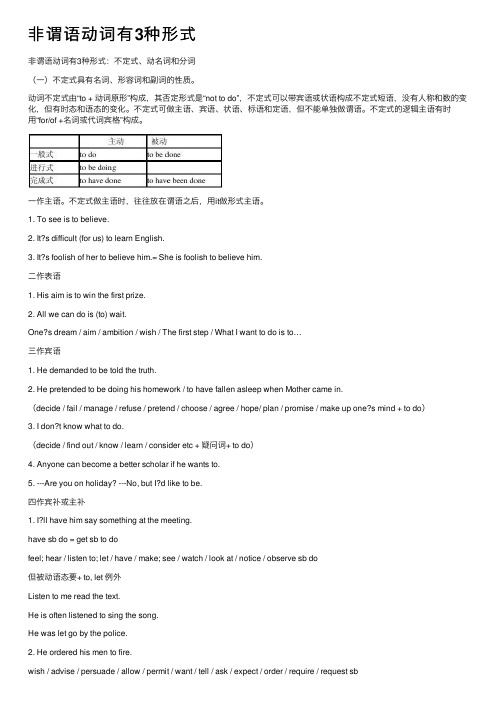
⾮谓语动词有3种形式⾮谓语动词有3种形式:不定式、动名词和分词(⼀)不定式具有名词、形容词和副词的性质。
动词不定式由“to + 动词原形”构成,其否定形式是“not to do”,不定式可以带宾语或状语构成不定式短语,没有⼈称和数的变化,但有时态和语态的变化。
不定式可做主语、宾语、状语、标语和定语,但不能单独做谓语。
不定式的逻辑主语有时⽤“for/of +名词或代词宾格”构成。
⼀作主语。
不定式做主语时,往往放在谓语之后,⽤it做形式主语。
1. To see is to believe.2. It?s difficult (for us) to learn English.3. It?s foolish of her to believe him.= She is foolish to believe him.⼆作表语1. His aim is to win the first prize.2. All we can do is (to) wait.One?s dream / aim / ambition / wish / The first step / What I want to do is to…三作宾语1. He demanded to be told the truth.2. He pretended to be doing his homework / to have fallen asleep when Mother came in.(decide / fail / manage / refuse / pretend / choose / agree / hope/ plan / promise / make up one?s mind + to do)3. I don?t know what to do.(decide / find out / know / learn / consider etc + 疑问词+ to do)4. Anyone can become a better scholar if he wants to.5. ---Are you on holiday? ---No, but I?d like to be.四作宾补或主补1. I?ll have him say something at the meeting.have sb do = get sb to dofeel; hear / listen to; let / have / make; see / watch / look at / notice / observe sb do但被动语态要+ to, let 例外Listen to me read the text.He is often listened to sing the song.He was let go by the police.to dosuggest / hope / agree / demand / arrange sb to do3. He is said to be doing the work of next year.It?s said that he is doing the work of next year.sb + seem / appear / happen / be said / be reported / be known /be found / be believed + to do / to be doing / to have ( been) doneIt + seem / appear / happen / be said … / be believe that….六作定语1. I have a lot of work to do / no pen to write with.2. the first to come / to be awarded the Nobel Prize3. the last person to do such a thing 最不愿意做…的⼈4. the house to be built next year⽐较: the house being built now / build last year注意(1)做定语的不定式如果是不及物动词,或者不定式所修饰的名词或代词是不定式动作的地点、⼯具等,不定式后应有相应的介词。
非谓语动词的三种形式与用法

非谓语动词的三种形式与用法非谓语动词是指在句子中充当其他成分而不担任谓语的动词形式。
一般来说,非谓语动词有三种形式:不定式、动名词和分词。
它们在句子中有着不同的用法和功能。
下面将详细介绍这三种非谓语动词的形式与用法。
一、不定式不定式是动词的一种形式,它可以作为名词、形容词或副词的补语,也可以作为谓语的补语。
不定式一般由“to + 动词原形”构成。
1. 作为名词的补语不定式可以作为名词的补语,起到与名词相同的作用。
例如:- My dream is to travel around the world.(我的梦想是环游世界。
)- I have a lot of work to do.(我有很多事情要做。
)2. 作为形容词的补语不定式可以作为形容词的补语,修饰名词或代词。
例如:- She has a book to read.(她有一本要读的书。
)- I am happy to see you.(见到你我很高兴。
)3. 作为副词的补语不定式可以作为副词的补语,修饰动词、形容词或副词。
例如:- He ran fast to catch the bus.(他快速地跑去赶公交车。
)- I woke up early to prepare for the exam.(我早早醒来准备考试。
)二、动名词动名词是一种以-ing 结尾的动词形式,它可以作为名词的主语、宾语、定语、表语等。
1. 作为名词的主语动名词可以作为句子的主语,表示某种行为或概念。
例如:- Swimming is good exercise.(游泳是一项好的锻炼。
)- Reading books is my favorite hobby.(阅读书籍是我最喜欢的爱好。
)2. 作为名词的宾语动名词可以作为某些动词的宾语,表示被动或完成的动作。
例如:- I enjoy swimming in the sea.(我喜欢在海里游泳。
)- She hates doing household chores.(她讨厌做家务活。
非谓语动词的形式和语态

非谓语动词的形式和语态非谓语动词在英语语法中占据着重要的地位。
它不仅可以作为动词的形式,还可以在句子中充当不同的语态。
本文将探讨非谓语动词的形式和语态,并举例说明它们在句子中的应用。
一、非谓语动词的形式非谓语动词有三种形式:不定式、动名词和现在分词/过去分词。
它们的形式和用法各不相同,下面将分别进行介绍。
1. 不定式不定式由"to"加上动词原形构成,例如:to go、to eat。
它有时可以带有助动词"to be",形成被动语态的不定式,例如:to be eaten。
不定式主要用于以下几个方面:- 表示目的或目标:I went to the store to buy some groceries.- 作为动宾结构的宾语:She wants to learn to play the piano.- 用于形容词后面修饰名词:She is the person to ask for help.2. 动名词动名词是动词加上-ing形式构成,例如:going、eating。
它可以作为主语、宾语、表语、介词宾语等。
动名词主要用于以下几个方面:- 作为主语:Swimming is my favorite hobby.- 作为宾语:I enjoy playing basketball.- 作为表语:Her favorite activity is dancing.3. 现在分词/过去分词现在分词由动词原形加上-ing构成,过去分词则根据动词的不同形式而变化,例如:going、eaten。
它们可以作为形容词修饰名词。
现在分词和过去分词主要用于以下几个方面:- 作为非限定性定语:The dog, barking loudly, scared the mailman.- 作为限定性定语:I saw a broken glass on the floor.- 作为表语:The situation seems confusing.二、非谓语动词的语态非谓语动词在句子中可以具有主动语态或被动语态。
动词的非谓语形式有三种
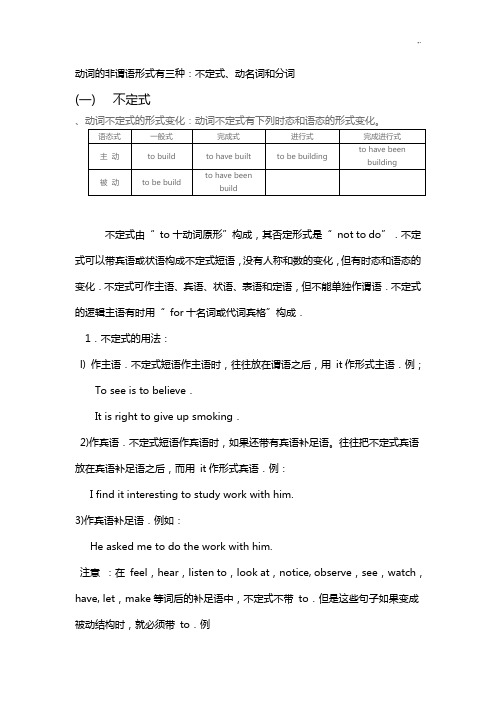
动词的非谓语形式有三种:不定式、动名词和分词(一)不定式不定式由“to十动词原形”构成,其否定形式是“not to do”.不定式可以带宾语或状语构成不定式短语,没有人称和数的变化,但有时态和语态的变化.不定式可作主语、宾语、状语、表语和定语,但不能单独作谓语.不定式的逻辑主语有时用“for十名词或代词宾格”构成.1.不定式的用法:l) 作主语.不定式短语作主语时,往往放在谓语之后,用it作形式主语.例;To see is to believe.It is right to give up smoking.2)作宾语.不定式短语作宾语时,如果还带有宾语补足语。
往往把不定式宾语放在宾语补足语之后,而用it作形式宾语.例:I find it interesting to study work with him.3)作宾语补足语.例如:He asked me to do the work with him.注意:在feel,hear,listen to,look at,notice, observe,see,watch,have, let,make等词后的补足语中,不定式不带to.但是这些句子如果变成被动结构时,就必须带to.例I often hear him sing the song.He is often heard to sing the song.注意:不定式动词在介词but,except,besides后面时,如果这些介词之前有行为动词do的各种形式,这些介词后的不定式不带to,否则要带to.如:She could do nothing but cry.What do you like to do besides swim?I have no choice but to go.4)作定语.例如:I have some books for you to read.注①作定语的不定式如果是不及物动词,或者不定式所修饰的名词或代词是不定式动作的地点、工具等,不定式后面须有相应的介词.例如:He is looking for a room to live in.There is nothing to worry about.Please give me a knife to cut with.但是,不定式所修饰的名词如果是time,place或way,不定式后面的介词习惯上要省去.例如:He had no money and no place to live.注②当作定语的不定式所修饰的名词或代词是不定式动作的承受者时,不定式既可以用主动语态,也可用被动语态,但其含义有所不同.试比较:A) Have you anything to send? 你有什么东西要寄吗?B) Have you anything to be sent? 你有什么要(我或别人)寄的东西吗?(不定式to be sent的动作执行者是已被省略的me或someone else)5)作状语,表示目的、原因、结果或条件.例如:I came here to see you.(目的)We were very excited to hear the news.(原因)He hurried to the school to find nobody there.(结果)To look at him, you would like him.(条件)目的状语还可以用in order to或so as to来表示.如:In order to pass the exam, he worked very hard.We ran all the way so as not to be late.不定式也可在作表语用的形容词后面作状语.例如:I am very glad to hear it.The question is difficult to answer.“too十形容词或副词十不定式”作状语.例如:He is too old to do that.另外句子中有enough这个词时,常用不定式作状语.例如:The room is big enough to hold us.6)作表语.例:My job is to help the patient.7)作独立成分.例;To tell the truth,I don’t agree with you.8)不定式与疑问词who,which,when,where,how,what等连用,在句中起名词作用,可充当主语、表语、宾语等.例如:He didn’t know what to say.(宾语)How to solve the problem is very important.(主语)My question is when to start. (表语)注意:在与why连用时,只用于why或why not开头的简短疑问句中,后面紧跟的动词不定式不带to. 例如:Why not have a rest?9)不定式在句中用主动式还是被动式。
非谓语动词的构成及其用法

不定式、动名词作宾语
• He chose not to go home this weekend. • The manager desires to see you. • My mother dislikes seeing you with me. • He could hardly resist laughing. • He is fond of playing tennis. • 动名词既可做动词宾语,也可做介词的宾语,而不定式只能做动词宾
4. Nobody is willing to go to a party without _____C______.
A. asking
B. to be asked
C. being asked
D. having asked
非谓语动词做宾语补足语
可以接不定式做宾语补足语的动词常用的有: ask, want, advise, allow, encourage, force,forbid,like, order, permit, persuade, request, require, tell, warn, urge, expect 这些词后均可接+sb. to do sth.的结构 Father will not allow us to play on the street. My teacher advised me to do more exercises.
➢ be/get used to, devote oneself to, ➢ look forward to, object to, prefer...to, ➢ refer to, pay attention to, stick to, lead to
这些词组里的to为介词,而非不定式符号。
动词的非谓语形式

动词的非谓语形式动词的非谓语形式有三种,即动词不定式,分词(现在分词和过去分词),动名词。
概说我们根据已经学过的语法知识知道,英语中动词有以下几类:助动词,情态动词,连系动词,行为动词(实义动词)。
助动词本身没有词义,不能单独使用,只能起到语法意义上的作用。
情态动词意思不完整,也不能单独使用,必须要和行为动词一起才能构成完整的意思,在句中作谓语。
连系动词作谓语时,后面接形容词和名词等作表语。
行为动词或实义动词在句中常作谓语,根据其后面能否直接带宾语,行为动词又可分为及物动词和不及物动词。
及物动词后面跟名词,代词或相当于名词的词作宾语,不及物动词必须要和一定的介词一起使用才能带宾语。
由上我们可以看出,行为动词在句中常常用做谓语,受主语的人称和数的限制。
但是,动词及其变化形式在句中也可以不作谓语来使用。
据此,我们又可将动词分为限定动词( finite verb )和非限定动词( non-finite verb )两类。
限定动词在句中作谓语,受主语的人称和数的限制,非限定动词在句中不可单独作谓语,不受主语的人称和数的限制,它在句中可以用作其他句子成分。
非限定动词有三种表现形式,既动词不定式,分词和动名词。
我们通常把这三种形式称之为动词的非谓语形式。
动词的非谓语形式或非限定动词在语法意义上具有双重性质:既具有动词性质,又具有非动词性质。
其动词性质表现在(1)有时式和语态的变化(2)可被状语修饰(3)及物动词须有宾语。
其非动词性质表现在(1)相当于名词(2)相当于形容词。
动词的三种非谓语形式与自己的宾语或状语连用就构成非限定动词短语,分别叫做动词不定式短语,分词短语和动名词短语。
动词不定式和动词不定式短语动词不定式在句中可作主语,主语补足语,宾语,宾语补足语,表语,定语,状语等。
动词不定式也有时式和语态的变化。
1.动词不定式作主语(a)To see is to believe.(b)To master a foreign language is of great importance today.(c)To teach is to learn.(d)It is a great honor to talk with you.2.动词不定式作主语补足语(a) He was seen to enter the hall.(b) It is reported to be true.(c)He is said to be from New York.(d)The young man was considered to have great promise.3.动词不定式作宾语(a) He seemed to know the secret.(b) I want to talk with him very much.(c) He liked to live there, However, he found it difficult to get used to the climate.4.动词不定式作宾语补足语(a)He begged me to give him a hand.(b)I would like you to have an opportunity to appreciate Chinese art.(c) I’ll leave you to attend the matter..(d) The boss made these workers work over 12 hours a day.5. 动词不定式作表语(a ) The duties of a postman are to deliver letters and newspapers.(b) My chief purpose has been to point out the difficulties of the matter.(c ) The important thing is to save lives.(d) The only thing I could do was to leave.(e) His wish is to become a doctor.6.动词不定式作定语(a)The next train to arrive was from Beijing.(b)He was always the first to come and the last to leave the office.(c)The four abilities to learn a language are listening, speaking, reading and writing.(d) Our need to communicate with each other has been a driving force in the developmentof technology.7.动词不定式作状语(a)He cupped his ears to hear better.(b)I stayed there to see what would happen.(c ) I come here to see you.(d) To emphasise the woman even more, Chen Yifei adds a lot of detail to the fan and thecloth of her dress.(e)Between 1933and 1940, Xu Beihong held several exhibitions in Asia and Europe topromote Chinese art.上述动词不定式或动词不定式短语在句中作目的状语。
- 1、下载文档前请自行甄别文档内容的完整性,平台不提供额外的编辑、内容补充、找答案等附加服务。
- 2、"仅部分预览"的文档,不可在线预览部分如存在完整性等问题,可反馈申请退款(可完整预览的文档不适用该条件!)。
- 3、如文档侵犯您的权益,请联系客服反馈,我们会尽快为您处理(人工客服工作时间:9:00-18:30)。
动词的非谓语形式有三种:不定式、动名词和分词(一) 不定式不定式由“ to十动词原形”构成,其否定形式是“ not to do”.不定式可以带宾语或状语构成不定式短语,没有人称和数的变化,但有时态和语态的变化.不定式可作主语、宾语、状语、表语和定语,但不能单独作谓语.不定式的逻辑主语有时用“ for十名词或代词宾格”构成.1.不定式的用法:l) 作主语.不定式短语作主语时,往往放在谓语之后,用it作形式主语.例;To see is to believe.It is right to give up smoking.2)作宾语.不定式短语作宾语时,如果还带有宾语补足语。
往往把不定式宾语放在宾语补足语之后,而用it作形式宾语.例:I find it interesting to study work with him.3)作宾语补足语.例如:He asked me to do the work with him.注意:在feel,hear,listen to,look at,notice, observe,see,watch,have, let,make等词后的补足语中,不定式不带to.但是这些句子如果变成被动结构时,就必须带to.例I often hear him sing the song.He is often heard to sing the song.注意:不定式动词在介词but,except,besides后面时,如果这些介词之前有行为动词do的各种形式,这些介词后的不定式不带to,否则要带to.如:She could do nothing but cry.What do you like to do besides swim?I have no choice but to go.4)作定语.例如:I have some books for you to read.注①作定语的不定式如果是不及物动词,或者不定式所修饰的名词或代词是不定式动作的地点、工具等,不定式后面须有相应的介词.例如:He is looking for a room to live in.There is nothing to worry about.Please give me a knife to cut with.但是,不定式所修饰的名词如果是time,place或way,不定式后面的介词习惯上要省去.例如:He had no money and no place to live.注②当作定语的不定式所修饰的名词或代词是不定式动作的承受者时,不定式既可以用主动语态,也可用被动语态,但其含义有所不同.试比较:A) Have you anything to send? 你有什么东西要寄吗?B) Have you anything to be sent? 你有什么要(我或别人)寄的东西吗?(不定式to be sent的动作执行者是已被省略的me或someone else)5)作状语,表示目的、原因、结果或条件.例如:I came here to see you.(目的)We were very excited to hear the news.(原因)He hurried to the school to find nobody there.(结果)To look at him, you would like him.(条件)目的状语还可以用in order to或so as to来表示.如:In order to pass the exam, he worked very hard.We ran all the way so as not to be late.不定式也可在作表语用的形容词后面作状语.例如:I am very glad to hear it.The question is difficult to answer.“ too十形容词或副词十不定式”作状语.例如:He is too old to do that.另外句子中有enough这个词时,常用不定式作状语.例如:The room is big enough to hold us.6)作表语.例:My job is to help the patient.7)作独立成分.例;To tell the truth,I don’t agree with you.8)不定式与疑问词who,which,when,where,how,what等连用,在句中起名词作用,可充当主语、表语、宾语等.例如:He didn’t know what to say.(宾语)How to solve the problem is very important.(主语)My question is when to start. (表语)注意:在与why连用时,只用于why或why not开头的简短疑问句中,后面紧跟的动词不定式不带to. 例如:Why not have a rest?9)不定式在句中用主动式还是被动式。
多数情况下是容易判别的,但有时的确比较复杂,请注意以下几点:A)不定式修饰的名词或代词和不定式构成逻辑上的主谓关系时,不定式往往用主动形式。
Have you got a key to unlock the door?B)不定式和它前面被修饰的名词或代词构成逻辑上的动宾关系,又和该句主语构成逻辑上的主谓关系时,不定式常用主动形式.I have got a letter to write.( I write letter.)He needs a room to live in.( He lives in a room.)I know what to do.( I do what.) 但这句如改为下列形式,不定式就得用被动形式:I know what is to be done.这是因为what is to be done是宾语从句,从句中的主语what是动词do 的动作对象C)不定式作表语形容词的状语,和句中主语构成逻辑上的动宾关系时,不定式多用主动形式,这是因为人们往往认为形容词后省去了for one或for people.例如:He is hard to talk to.( to talk to him.)The book is difficult to understand. ( to understand the book.)但如果强调句中的受事者时,亦可用不定式被动式,例如:The handwriting is very difficult to be read.The box is too heavy to be lifted.D)在“there十be” 的结构中,当说话人考虑的是必须有人去完成某件事时,不定式用主动形式,如果说话人强调的是事情本身必须完成,则用被动形式.There is a lot of work to do. ( Somebody has to do the work.)There is a lot of work to be done.( The work has to be done.)请注意下面两个句子的含义是不同的:There is nothing to do. 意为无事可做,感到十分乏味.There is nothing to be done.意为某东西坏了,无法使之恢复正常.2.不定式的时态l)不定式的一般形式所表示的动作,通常与谓语的动作(状态)同时(或几乎同时)发生,或是在它之后发生.例如:I saw him go out.2)如果谓语表示的动作(情况)发生时,不定式表示的动作正在进行,这时不定式就要用进行式.例如:I am very glad to be working with you.3)如果不定式的动作发生在谓语动词之前,就要用完成式.例如:I’m sorry to have kept you waiting.3.不定式的语态当不定式逻辑上的主语是这个不定式所表示的动作的承受者时,不定式一般要用被动形式。
例如:He asked to be sent to work in the countryside.It is possible for our hopes to be realized.2.分词的用法l)作定语分词短语做定语时,放在被修饰的名词之后;单个分词做定语时,放在被修饰的名词之前.例如:The man standing by the window is our teacher.The excited people rushed into the building.注意:现在分词作定语时,它表示的动作是正在进行或与谓语动词所表示的动作几乎同时发生,如果两个动作有先有后,一般不能用现在分词作定语,而要用定语从句。
例如:The teacher criticized the student who had broken the window.现在分词作定语的差异:现在分词在句中作定语时,不仅存在前置与后置的区别,而且存在状态、时间与形式上的差异。
一、状态差异现在分词作定语明显存在状态差异。
一般来讲,前置的现在分词静感强。
而后置现在分词动感强。
学习时要注意体会这一点。
例1:The labouring people are the wisest.例2:The farmers labouring here are not afraid of snakes.能前置的现在分词为数不太多,常见的大都是已被形容词化了的现在分词。
这一点主要表现在有些现在分词前常有程度副词,有些现在分词甚至还有比较等级。
例3: I have brought very exciting news to you.例4:This is the most exciting story that I have ever read.二、时间差异时间差异指现在分词表示的动作发生的时间差异。
有些现在分词作定语时表示正在进行的动作。
这些现在分词若改为定语从句宜用进行时态。
例5:Did you tell the children playing there not to make any noise?Did you tell the children who were playing there not to make any noise?例6:The American president visiting China now will return on Saturday.The American president who is visiting China now will return on Saturday.有些现在分词作定语时则表示经常性动作或现在(或当时)的状态。
